Are you thinking of reaching those beautiful mountains again with your kids, but feel scared to be hiking with your toddlers?
We feel you! We’ve been hiking with our two kids since they were babies and we learned a few things the hard way.
It’s why we created this resource for parents thinking of hiking with their toddlers.
Disclaimer: Just a heads up, this free article contains affiliate links. If you purchase after clicking one of these links, I may earn a small commission at no additional cost. Also, as an Amazon Associate, I earn from qualifying purchases. Your support helps me continue to provide helpful and free content for you.
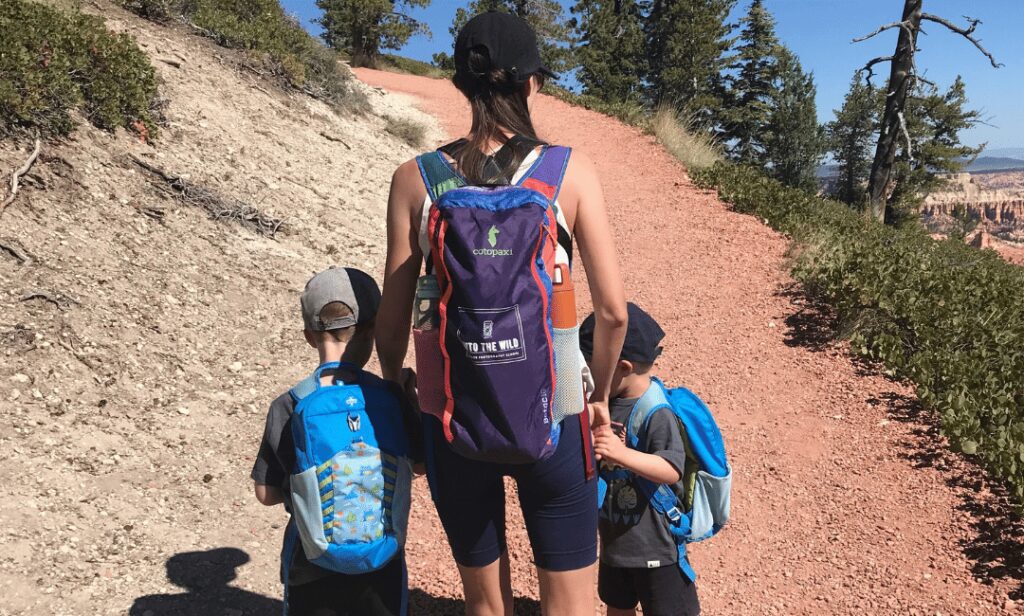
How to Hike with a Toddler: General Tips
Kids change a lot between 2 and 5, so there are plenty of age-specific tips you’ll want to bear in mind when hiking with a toddler. But some things remain applicable throughout these years.
Here are some of the most important tips to help you make hiking with toddlers both fun and safe.
1. Bring a Quality Baby/Hiking Carrier
Even if you have older toddlers who are used to walking, a good baby/hiking carrier is a must when hiking with toddlers. There’s nothing worse than getting midway through a trail only for your little one to decide they aren’t taking another step.
📖 You may want to read this to learn about the best baby & kids’ carriers.
For younger toddlers, a hiking backpack to carry your toddler also give you the flexibility to tackle more challenging trails that aren’t suitable for their little legs. They can even take a nap from the comfort of your back.
There are so many great hiking back to carry your toddler. We loved our Ergobaby carrier and our Tula carrier. We’ve never been big fan of the big hiking carriers, but some families love the Osprey hiking backpack and the Deuter hiking backpack.
Oh I remember those days…

Older toddlers might not need to be carried for as long, but they’ll still appreciate the option of taking a break occasionally. Better to have the carrier with you and not use it than face tantrums from tired kids or end up carrying them in your arms for kilometers.
What to Look For in a Hiking Backpack to carry your Toddler
Look for a carrier that is comfortable, lightweight, and will grow with your kid. Many baby carriers that are specifically designed for hiking come with useful extra features, such as storage pockets to carry your essentials.
- Hiking Backpack (or structured carrier)
Although they can be pricy, a good carrier is more than worth the investment, so be sure to shop around to find one that meets your needs.
If you plan on doing long hikes carrying your toddler, a structured hiking carrier would be a good investment, especially if you’re used to hiking (pre-kids). Your toddler will be comfortable and you’ll have more back support while hiking on longer trails. Plus, those hiking carriers usually come with an extra backpack to store all your hiking essentials and snacks.
The Osprey hiking backpack and the Deuter hiking backpack both have great reviews from hiking families.
- Baby Carrier (or soft carrier)
For older toddlers or for tiny toddlers (and infants), a soft toddler carrier is perfect. They are more compact than structured carriers and can be easily put away in a day backpack while your toddler is actually hiking. For example, Tula has a soft carrier for toddlers that goes up to 65 lbs. It can last for a few years.
It’s the one we used for years when hiking in national parks and the Canadian Rockies.
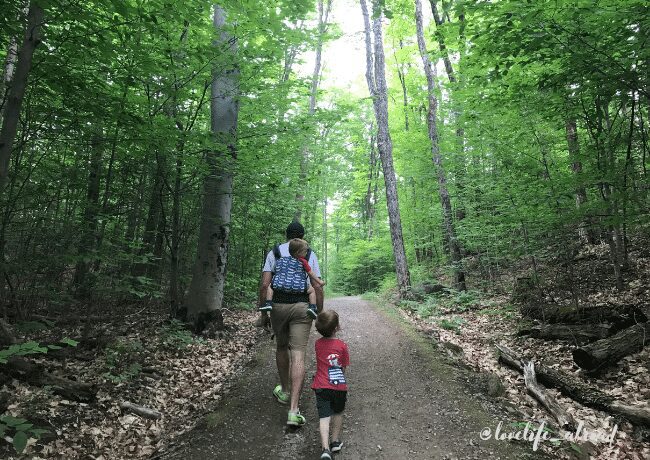
2. Bring Plenty of Snacks and Water
Avoid mid-trail meltdowns by making sure you have plenty of snacks and water available. Trail mix, cheese, carrot sticks, apple slices with peanut butter, cereal bars – there are lots of options that are easy to carry along and will provide a much-needed energy boost when their small legs are feeling tired.
Don’t forget the “Leave No Trace Principle“: Bring back everything you brought on the trail.
Snacks can also be used to bribe reluctant toddlers to hop out of the carrier and walk for themselves for a while.
Older toddlers might enjoy carrying their own water and snacks. But make sure that you have some backups in your own bag, as children aren’t great at pacing themselves and are likely to finish off everything within the first kilometre.
3. Plan Hikes Around Napping Schedules
Although not every toddler has a regular napping schedule, most are still taking at least one nap a day until they are three or so. Try to time your hikes with their usual naptime in mind, or you’ll end up with a tired and grumpy kid, which is no fun for anyone.
It’s also best to avoid hiking too late in the day when kids get more tired and low in energy. I know it can be tempting to go for a sunset hike in the summer, but it may not always end well. Hikes with toddlers are usually best when planned for earlier in the day.
If you have a child who naps well in the carrier, you’ll have a bit more flexibility when you go on your hikes. However, a sleeping toddler can’t be put down to walk themselves, so consider your own stamina for carrying them, especially if the trail involves lots of gain in elevation.
4. Pack a Hiking First Aid Kit
We really hope you won’t need it, but never forget to take a hiking first aid kit with you when hiking with toddlers. Make sure it is well-stocked, especially with bite/sting cream and band-aid – you never know when unsteady little legs might take a tumble.
Keep your hiking first aid kit somewhere accessible – in its own pouch or at the top of your pack. You want to be able to grab it quickly in an emergency.
As well as the usual bandages, plasters, and tweezers, keep some fun patterned plasters in your kit to cheer up little ones who are feeling a bit wobbly about continuing after a fall. Sun cream and insect repellent are also useful to have on hand, especially in the summer.
We love the Adventure Medical Kit.
5. Include an Epi-Pen
Even if your children don’t have any known allergies, make sure you have an epi-pen available in your hiking first aid kit in case of an emergency. The last thing you want is to suddenly discover they are allergic to an insect or plant when you are out in the wilderness and can’t immediately get help.
Keep it in your hiking first aid kit or in another accessible place. Make sure you know how (and when) to use it before you set off and check the date periodically to make sure it hasn’t gone out of date.
These tips hold true no matter what age your toddlers are. But their needs change as they grow, and so will your family-friendly hikes.
So let’s look at some specific tips to consider when hiking with toddlers of different ages.
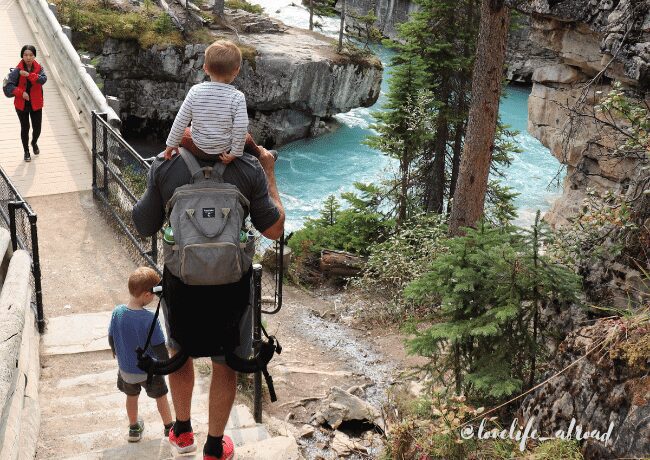
Hiking With Toddlers: Tips for Hiking with a 2-Year-Old
While they tend to be fiercely independent, most 2-year-olds are still building their endurance and stability. They are past the stage where they are happy to sit quietly in the carrier and observe the world for hours, but their little legs aren’t ready for the longer hikes just yet.
This is a great age for introducing your toddler to the joys of hiking. But you’ll need to plan your adventures carefully to make them enjoyable for everyone.
Here are a few tips for hiking with a 2-year-old toddler.
6. Keep it Short and Sweet
Quality is definitely better than quantity when hiking with a 2-year-old. They tend to have limited attention spans and don’t yet have the physical capacity to walk long distances.
Keep your hikes super short when hiking with toddlers in this age group. No more than 1-2 km, especially at first. Although that might feel like a frustratingly short distance to the adults, it won’t be long before they can go further. Honouring their capacity now will help instill a love of hiking later in life.
The GoWhee App is a great app to search for kid-friendly hikes. All the trails and hikes added to the app had been tested by parents with their kids. You’ll have an honest review and will be able to find the perfect hike for your family.
Plan scenic routes to keep your toddler engage and prevent boredom, especially if they are spending part of the hike in the carrier.
AllTrails is another great app for finding trails. You can search for family-friendly hikes and read reviews to get a better idea of the trail.
7. Bring a Change of Clothes
2-year-olds manage to get sticky even when sitting in a perfectly clean house, so you can imagine what sort of state they can get into on a hike. Many 2-year-olds are also at potty training stage where things can be a bit hit-and-miss.
To avoid any wardrobe disasters, have a spare pair of clothes with you. You may want additional extra pairs of socks and underwear, just in case. A pack of wet wipes or reusable cloths is another necessity for on-trail clean-ups.
A small waterproof bag can be useful too – put any wet or dirty clothes in it to keep them separated from the rest of your gear.
8. Don’t Forget Their Comforter
If your 2-year-old has a special stuffed toy or blanket they use to comfort themselves, make sure you bring it with you on your adventures, so it is to hand if there are any meltdowns.
Depending on how replaceable the comforter is, you may want to leave it safely in the car while you go on the hike itself. Tired children are often reluctant to settle into their car seats after an adventure. Having their comfort object to hand when they return to the car will help them be more patient on the journey.
If you do decide to take the blanket or toy on the hike itself, it is a good idea to attach it to your pack or carrier in some way. Plenty of places sell inexpensive pacifier clips that can be repurposed for other objects too. Or make your own.
By clipping the toy to the carrier, your toddler can give it a cuddle without worrying about it getting dropped and left behind.
Hiking With Toddlers: Tips for Hiking With 3-Year-Old Toddlers
By the time they are 3, your toddler will probably be capable of walking further distances. They may still want to be carried at times, however. The trick is finding the balance between their growing need for independence and their ability to keep up with the rest of the family.
9. Aim for Medium Hikes
The energy level of the average 3-year-old varies wildly from day-to-day. One day they seem like they’ll never slow down, and the next day they act like they’ve forgotten how to walk altogether.
Most toddlers in this age group will be ready to start doing slightly longer hikes of around 2-3km but be prepared to carry them for a good chunk of it if it turns out to be an off day. They’ll likely still need help with steep inclines and declines too. Try to find easier routes that are mainly on the flat or only have a small gain in elevation.
Plan frequent breaks when hiking with a 3-year-old to allow them rebuild their energy levels for the next part, and don’t expect them to carry their own gear for the whole hike, even if they are keen to try at the start.
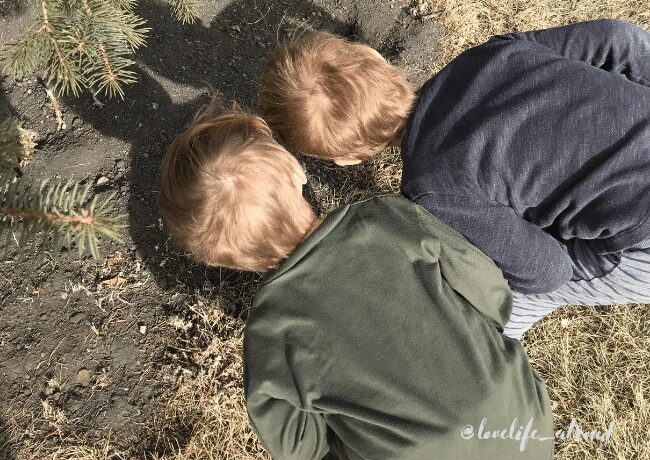
10. Invest in Good Quality Footwear
Toddlers starting to walk more need good-quality hiking shoes or boots for their adventures. Look for sturdy, durable footwear that is waterproof enough to survive enthusiastic puddle jumping.
Before you go on a longer hike, give your toddler plenty of opportunities to break in their new shoes. You want to make sure they are comfortable and don’t rub. Blisters are no fun for anyone.
What Hiking Shoes to Get When Hiking with Toddlers?
It is worth spending a little extra on footwear to make sure your toddler’s boots or shoes will last well and offer their developing feet good support while out on the trail.
Vivobarefoot Hiking Shoes 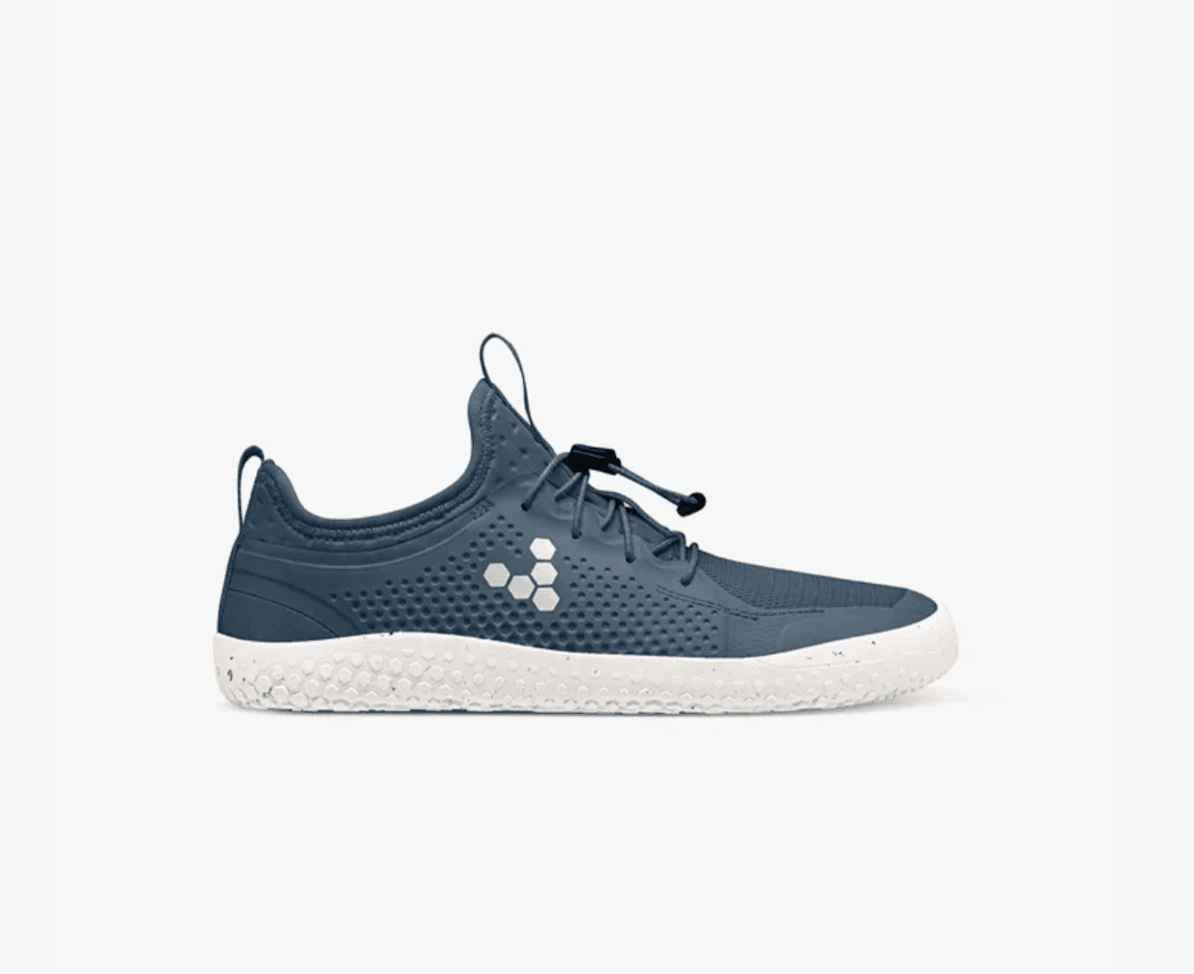 | KEEN Hiking Sandals 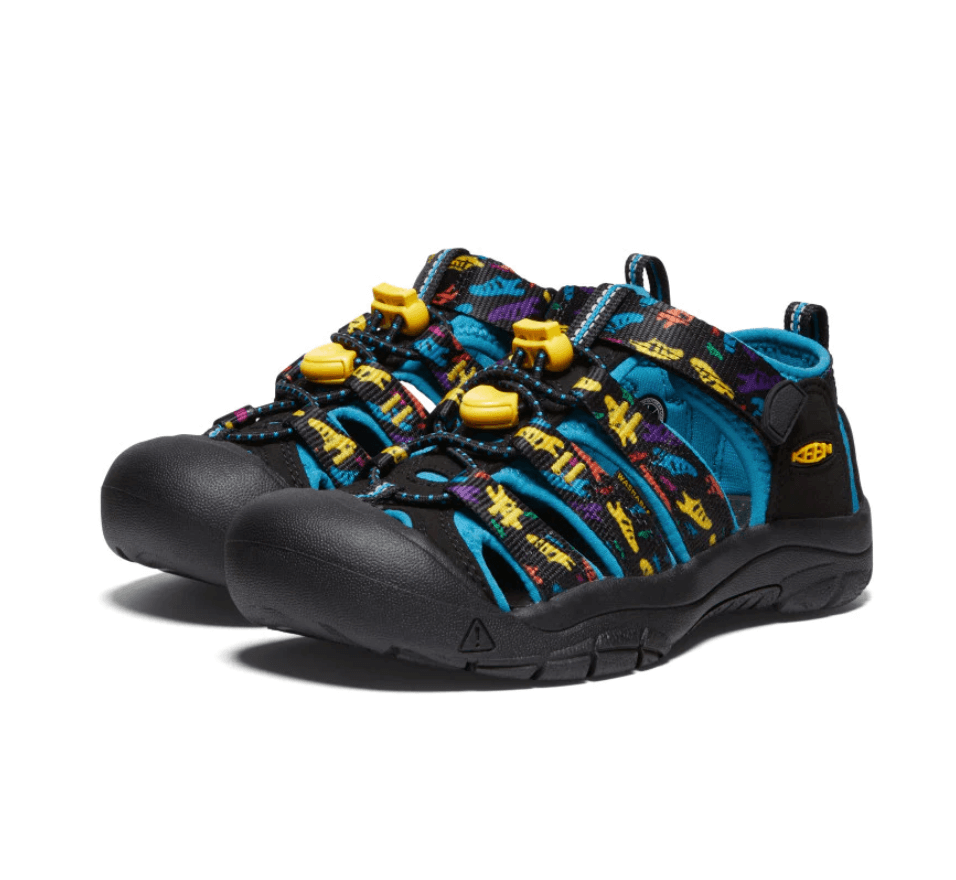 | Decathlon Hiking  |
- Vivobarefoot
Our boys love their VivoBarefoot shoes. (Use this code if you purchase from the Canada website for 15% off: LOVELIFEABROAD15).
“Feet on the earth, hands in the dirt, eyes on the horizon”, this is Vivobarefoot philosophy for childhood.
Isn’t it so inspiring?
With their Vivobarefoot shoes, the kids can now be closer to nature, feel the dirt and terrains beneath their feet.
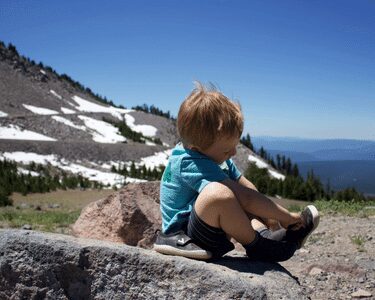

- KEEN Footwear
KEEN Footwear is a good option for kids. They have great hiking shoes and sandals.
11. Start Identifying Colors in Nature
Hiking is a fantastic way to give your kids a lifelong love of the outdoors. Encourage your 3-year-old to start engaging more with what they see on your hikes by getting them to identify the many different colours around them. Can you find the whole rainbow?
The classic game, I-Spy, can be adapted for this age group by using colors instead of letters. Get the whole family involved to encourage your kids to develop their powers of observation.
Many 3-year-olds will start learning their numbers too, so you can get them practicing by asking them to count things along the way. Animal noises are another fun game – who can do the best impression of the creatures you spot on your path?
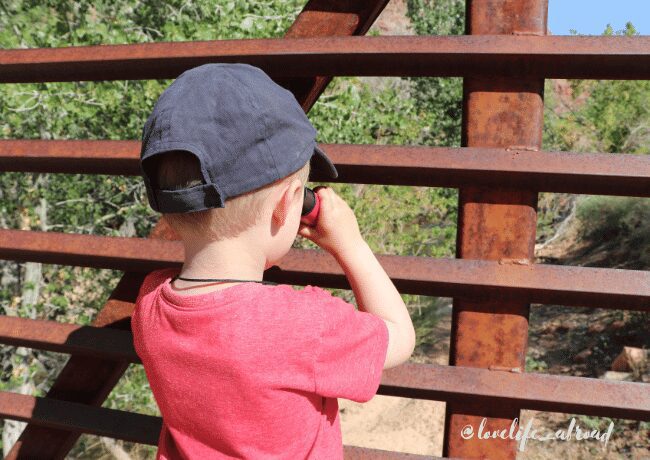
Hiking With Toddlers: Tips for Hiking With 4-Year-Old Toddlers
Inquisitive and ready for adventure, most 4-year-olds are curious about the world around them. They might have more physical endurance and ability too, meaning you can start to introduce some more challenging hikes.
Of course, this age group also has strong opinions, and you’ll need to keep them on board with your plans if you want the hike to be a fun outing for everyone.
12. Stop at the Interpretive Signs
By the time they’ve reached the age of 4, most kids are starting to understand a lot more about the world around them and how it all fits together. Although they still have moments when they seem more babyish, toddlers of this age are keen to learn and can understand more complex information than younger kids.
Take advantage of their burgeoning interest in the wider world by stopping to read interpretive signs and guides along your way. As well as giving them a short break to catch their breath, it gives your toddler a chance to learn new things.
Don’t expect them to retain everything at this age. You never know what will go in and what won’t. Follow your toddler’s interests – if they want to know more, you can talk about what you’ve learned, but it is time to move on if they seem bored.
13. Learn to Start Identifying Trees and Plants by Name
Hiking with 4-year-olds is a great opportunity to hone their observational skills and teach them more about the natural world. Spark their interest by identifying common plants and trees you see along your way.
You can also register to an outdoor subscription box like WildLife Outdoor Adventure or the Think Outside boxes for activities to do when hiking with your 4-year old.
Although it is important to reinforce the lesson that they should never eat a plant unless an adult says it is OK, some easy foraging can be the best introduction to plant identification. Many toddlers are fascinated to find that some of the plants they see on their adventures are edible.
Another vital early lesson is which plants should be avoided. Children quickly learn to identify stinging nettles or poison ivy, hopefully before they are stung too many times.
Don’t worry if you don’t know much about plants yourself yet. This is a chance for the whole family to learn. There are now plenty of apps you can get to help you identify plants and trees while you are out and about. Or you can take pictures and look them up when you get home.
When your toddler sees you being curious and wanting to learn more, their own interest will be sparked. Get them to help you with the research and talk about how you can find out about plants you don’t recognize yet.
14. Involve Them in the Planning
Most 4-year-olds love to see themselves as ‘big kids’ and they are keen to prove that they can help out. Nurture that enthusiasm and get them excited to go hiking by getting them involved in planning your adventures.
At this point, your toddler should be ready to carry their own little bag, as long as you keep the contents minimal so that it doesn’t weigh too much. They could plan and pack their own provisions, including helping with making snacks for the trail.
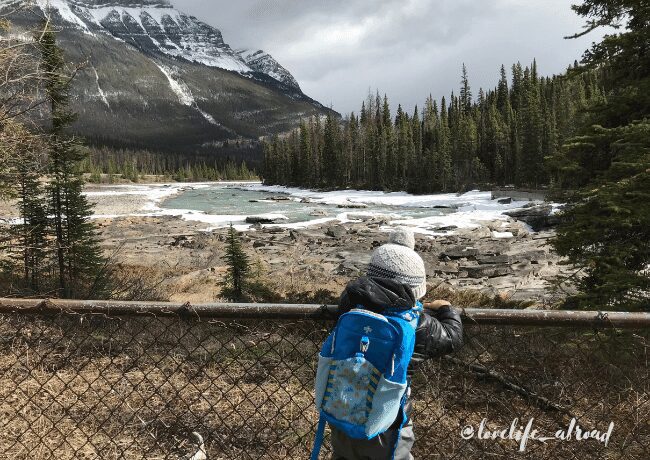
Make a packing checklist together, along with pictures, and ask your child to help you gather the items you’ll need. They can tick off the items as you go.
You can also get your 4-year-old involved in planning the route. Perhaps you already have some favorite family trails and they can choose which one to visit. If you are in a new area, you could give them some options and let them pick the one they want to do.
Hiking With Toddlers: Tips for Hiking With 5-Year-Old
There’s a difference between hiking with a 2-year-old and hitting the trails with a 5-year-old. Not only is their physical ability much higher, but so is their ability to understand and learn about the natural world.
Your 5-year-old will still need plenty of snack breaks and gentle encouragement. But they are also ready to take a more active role in your adventures. Keeping things fun is essential for this age group to prevent them from getting bored as you explore some longer trails.

15. Create a Scavenger Hunt Before You Go
5-year-olds love games and challenges, so you can make hiking more fun and engaging for them by turning it into a scavenger hunt.
It is best to create your scavenger hunt before you go hiking since coming up with ideas on the fly can be a challenge. This also means you can add pictures or drawings of the items you want your child to look out for.
You can vary the items depending on the season to encourage your 5-year-old to notice how everything changes as the months go past.
Alternatively, you can ask them to find items that are a certain color or meet other criteria. Something you can eat, somewhere a bug might live, something that comes from a tree, etc.
Not only does a scavenger hunt make the hike more fun, but it also encourages your child to look more closely at the world around them.
16. Ask Lots of Questions
Spend any time with a 5-year-old, and you quickly realize you’ve arrived at the ‘why’ stage. Why is the sky blue? Why does ivy grow on trees? Why do animals hibernate?
To avoid spending your whole hike answering the many (and bizarre) questions your 5-year-old throws at you, turn the tables and ask them questions instead.
This encourages them to look around them and think about their surroundings. Make it clear that they don’t need to come up with the right answer – the point is to think and discuss their ideas. How might they find out if they aren’t sure of the answer? Help them develop their research skills by suggesting ways to test their ideas or discover new information.
You never know where these discussions might take you. Be prepared to do some follow-up work when you get home – time in nature is a great way to spark curiosity.
Taking photos of your family adventures and all the beautiful scenery you discover on the way is a fantastic way to record your memories for the future. But it doesn’t always need to be an adult behind the camera.
Bring trusted with the camera is a big deal for many kids and will hopefully spark a lifelong love of photography. Your 5-year-old should be ready to learn the basics of using a camera and can start to get their eye in.
Granted, you’ll likely end up with some pictures up people’s noses or of their feet at first. But the beauty of digital cameras is that there’s plenty of experimentation opportunities. The more they get used to using the camera, the better your child will get at taking genuinely beautiful photos.
Once you get home, you can look at the images together and decide which ones you like best. When you next want to go out, you can use pictures from past hikes to plan future adventures.
Plus, with your 5-year-old acting as the lead photographer, there’s a chance you’ll get your own face into the family album again without needing to take loads of selfies.
F.A.Q How to Hike With a Toddler
What age is appropriate for hiking?
There is no right age to be hiking with toddlers. When they are little, it’s easier to go longer hikes since you’ll be carrying your kids. As they become more independent, the hikes will be shorter, but they’ll get to walk all by themselves.
Can I take my 2-year-old hiking?
Yes, you can take your 2-year-old hiking.
Can you take a stroller on a hike?
You can bring a stroller on a some hike, but not on all hikes. I recommend you look for wheelchair-accessible trails on Alltrails, they will most likely be stroller-friendly.
How do I make my toddler hike fun?
The best way to may a toddler hike fun is to follow your child’s pace and interest Find trails with fun features for kids such as a waterfall, rocks, river. Bring lots of snacks and don’t worry about time.
Final thoughts: How to hike With a Toddler
With those 17 tips for hiking with toddlers, you are not ready to hit any family-friendly hikes. Don’t forget at hiking with a toddler is more about the journey than the destination. But more than anything, it instills their love for the outdoors.
Let your toddler leads the way and shares your love of hiking and the outdoor with them. They will slowly become amazing hikers.
Do you have any tips to share with us?
Related Articles – Hiking With a Toddler
- Hiking in Spain in April: What to Know & Our Best Trails
- 12+ Outdoor Adventures for Families to Put on Your 2023 Travel List
Emilie is the founder of Love Life Abroad. She helps moms plan epic road trips and outdoor adventures with their families. Because who said adventuring had to stop once we have kids? She’s based in the Canadian Rockies and shares her love for the region as well as other unique places in Canada & USA. She works with tourism boards and outdoor brands to inspire families to experience new unique destinations and outdoor activities.
